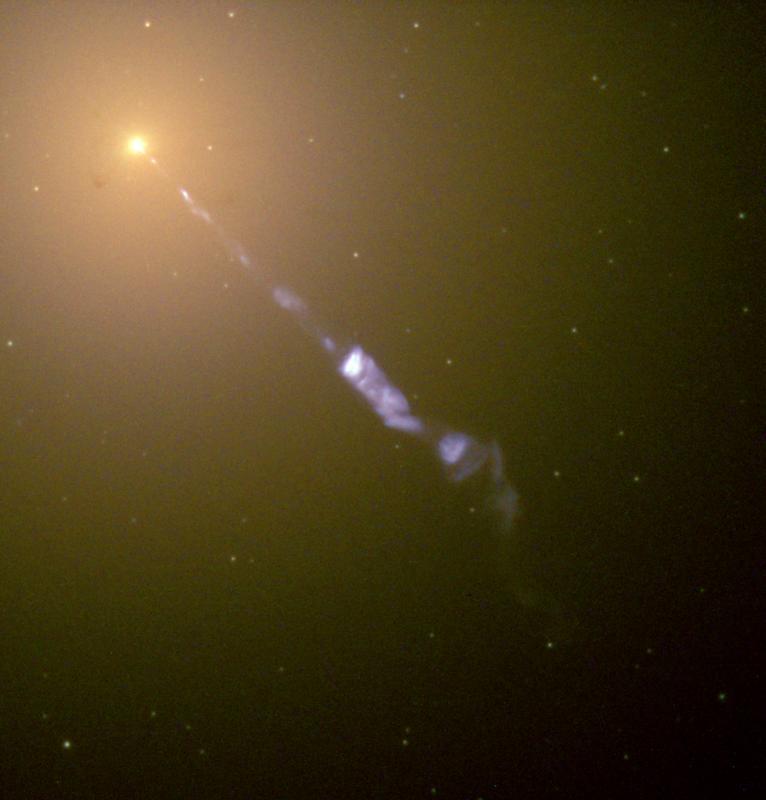







| BOOKS | F. A. Q. | ARTICLES | TALKS | ABOUT KEN | DONATE | BEYOND OUR KEN |
|---|
By Ken Croswell
Published on ScienceNOW (April 24, 2012)

Gargantuan galaxy: big elliptical galaxies, such as M87, are full of little stars--and no one knows why. Credit: The Hubble Heritage Team (STScI/AURA)/NASA.
Astronomers usually assume that every galaxy gives birth to the same mix of stars as our own. Now a large, new study contradicts this assumption, finding that giant elliptical galaxies--round or ellipsoidal systems full of ancient stars--spawned an excess of little stars just after the big bang. No one knows why, but the result suggests that galaxies in the early universe created stars differently than they do today.
Like snowflakes, no two stars are the same. In our Galaxy, newborn stars span an enormous range of masses: a few rare superstars arise with more than 100 times the mass of our Sun, but the vast majority is composed of dim red dwarfs with just a fraction of the Sun's mass. The largest stars explode soon after birth, rocking their cradles and enriching their galaxies with planet- and life-forming materials such as oxygen and iron, while stars born small live quiet lives and make little contribution to their galactic homes.
In 2010, Pieter van Dokkum of Yale University and Charlie Conroy of the Harvard-Smithsonian Center for Astrophysics in Cambridge, Massachusetts, used spectroscopic observations to discover that eight massive elliptical galaxies had given birth to an even greater proportion of small stars than the Milky Way did. Our Galaxy is a spiral--a barred spiral, to be exact--that has produced stars over its entire life, whereas most elliptical galaxies formed all their stars long ago.
Now, in a much larger study and using a different technique, astronomer Michele Cappellari of the University of Oxford in England and his colleagues have confirmed and strengthened the conclusion that old galaxies formed a plethora of little stars. The astronomers compared the masses of 260 galaxies with their output of light, deducing the initial mass function--the birth distribution of stellar masses from high to low--in each galaxy. As the astronomers report online today in Nature, different galaxies gave birth to dramatically different mixes of stars. Although some of the galaxies have initial mass functions like the Milky Way's, others have a far greater proportion of small stars, with the most massive elliptical galaxies being the most extreme.
Cappellari doesn't know why those galaxies churned out so many small stars. "All we know is that the elliptical galaxies formed most of their stars in more intense bursts of star formation," he says. "But it's not clear why this different type of star formation should produce the initial mass function we observe."
Astronomer Pavel Kroupa of the University of Bonn in Germany says the new work provides convincing evidence for a varying initial mass function. "It's extremely exciting," he says. But it means astronomers need to recompute their models of how galaxies evolve, because a different mix of stars affects how rapidly a galaxy builds up life-giving heavy elements. Ironically, Kroupa recently proposed doing just that, but he was turned down. "The referee reports were pretty ugly," he says, citing the widespread belief that the initial mass function is universal. "I'm still pretty angry."
Ken Croswell earned his Ph.D. in astronomy from Harvard University and is the author of The Alchemy of the Heavens and The Lives of Stars.
"An engaging account of the continuing discovery of our Galaxy...wonderful." --Owen Gingerich, The New York Times Book Review. See all reviews of The Alchemy of the Heavens here.
"A stellar picture of what we know or guess about those distant lights."--Kirkus. See all reviews of The Lives of Stars here.
| BOOKS | F. A. Q. | ARTICLES | TALKS | ABOUT KEN | DONATE | BEYOND OUR KEN |
|---|